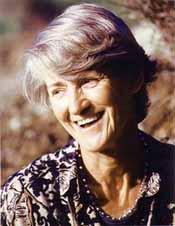 Featured
Scientist: Maeve Leakey
Featured
Scientist: Maeve Leakeysource of image
Notes for Evolution - The Triumph of an Idea - Chapter 11
Click link to return to Biology
409 Schedule
or back to Chapter 10 or ahead to Chapter
12
General guide on these review questions here
Chapter 11 - The Gossiping Ape - The Social Roots of Human Evolution
PBS Website How Did Humans Evolve?
Objectives:
a) Gain an overview of human evolution based on a combination of current molecular evidence and current understanding of the hominid fossil record.
c) Explore the key anatomical and cultural innovations that have made humans so successful.
d) Consider the extent to which evolutionary arguments that appear to provide explanations for behavior in other animals might also apply to humans.
e) Evaluate the emerging notion that humans have sophisticated innate language modules that extend across cultures, and relate these to the dramatic increase in brain size and intelligence in the evolution of Homo sapiens.
 Featured
Scientist: Maeve Leakey
Featured
Scientist: Maeve Leakey
source
of image
I. Introduction
II. Darwin's African Guess
RQ Ev-11.1: Refer to the evolutionary tree on p. 263. It is based on extensive DNA sequence comparisons and is relatively current and generally considered robust by experts in this field. Use this tree to answer the following:
a) According to this tree, what is the sister taxon of humans?
b) How many species belong to this sister clade? (Note: Experts have different opinions on this question, because it depends on the species concept employed.)
c) Contrast the extent of genetic divergence (as estimated by sequence comparisons) in humans compared with the most closely related species to humans.
d) Based on known fossils discussed in the text, put an approximate date estimate on the node (i.e., last common ancestor) uniting humans with their sister taxon.
e) Do the same for the node uniting modern humans.
RQ Ev-11.2: Refer to the evolutionary tree on p. 264. This summarizes current understanding of the hominid fossil record. Hominids are comprised of the earliest common ancestor that is more closely related to humans than to chimps, and all its descendants. Use this tree to answer the following:
a) How many separate lineages of hominids have either gone extinct or are still living? (Note: The wording of this question forces you to ignore "chronospecies" directly on a branch, that later evolve into another species. Anthropologists still tend to over-use chronospecies.)
b) For the last 3 My, describe in general terms the pattern of hominid speciation, including how many species have lived simultaneously.
c) Briefly characterize the association of key hominid physical adaptations with particular branching points.
d) Do the same for key hominid cultural innovations.
III. Tools and Alliances
RQ Ev-11.3: How do autistic people or those with Williams syndrome help reveal how humans manage their social intelligence?
IV. Evolving a Theory of Mind
RQ Ev-11.4: What evidence suggests that humans are more egalitarian than our chimp relatives?
V. Pleistocene Passions
RQ Ev-11.5: Explain the rationale and evidence behind the claim by evolutionary psychologists that animals (including humans) tend to prefer potential mates with symmetrical features.
VI. Not So Happily Ever After
RQ Ev-11.6: As championed by evolutionary psychologist, David Buss, what evidence suggests that jealousy can be an adaptive trait?
VII. Module or Mirage?
RQ Ev-11.7: Contrast evolutionary explanations for your choice of a particular example of human behavior, as represented by opposing schools of thought: current evolutionary psychologists (i.e., "sociobiologists") versus "exaptationists" such as Gould and Lewontin. For the latter, relate your argument to their 1979 analogy of the spandrels of St. Mark's.
VIII. Toward Language
RQ Ev-11.8: How does the invention of Nicaraguan sign language provide evidence that humans have a sophisticated innate command of syntax and general language modules in their brains.
Links to Human Evolution from Prof. Eernisse's Evolution course
Click link to return to Biology
409 Schedule
or back to Chapter 10 or ahead to Chapter
12
This page created 2/3/03 © D.J. Eernisse, Last Modified 4/27/03, Links Last Completely Checked 4/27/03